How to Create a Habitat That Mimics Chinchilla's Natural Environment

Chinchillas are small rodents native to the Andes Mountains in South America. In the wild, they inhabit rocky, arid regions with plenty of opportunities for climbing and hiding. To create a suitable habitat for your pet chinchilla, it's essential to mimic their natural environment as closely as possible.
First and foremost, providing a spacious cage or enclosure is crucial for chinchillas. They are active animals that need room to run, jump, and play. A multi-level cage with platforms and ramps can help simulate the rocky terrain they would encounter in the wild. Additionally, including a dust bath area is essential for chinchillas to maintain their fur health.
Chinchillas also require a diet rich in hay, supplemented with pellets and occasional treats. Ensuring they have access to fresh water at all times is vital for their health and well-being. Providing wooden chew toys and branches for them to gnaw on is essential for keeping their teeth healthy, as chinchillas' teeth continuously grow throughout their lives.
Creating a comfortable and stimulating environment for your pet chinchilla will help ensure they lead a happy and healthy life in captivity. Regular interaction, proper care, and attention to their environmental needs will contribute to their overall well-being and longevity.
Understanding Chinchillas' Native Habitat
In their natural habitat, chinchillas thrive in arid, rocky terrain with limited vegetation, showcasing their remarkable adaptability to harsh environments. Chinchillas are known for their exceptional ability to navigate rocky landscapes and survive with minimal water intake.
When exploring burrow systems, these small rodents exhibit cautious yet inquisitive behavior, carefully examining potential hiding spots and escape routes. Their social behaviors are also fascinating to observe, as they communicate through a variety of vocalizations and body language cues. Studying social behaviors within chinchilla colonies reveals complex hierarchies and cooperative behaviors essential for their survival in the wild.
Choosing the Right Bedding Materials
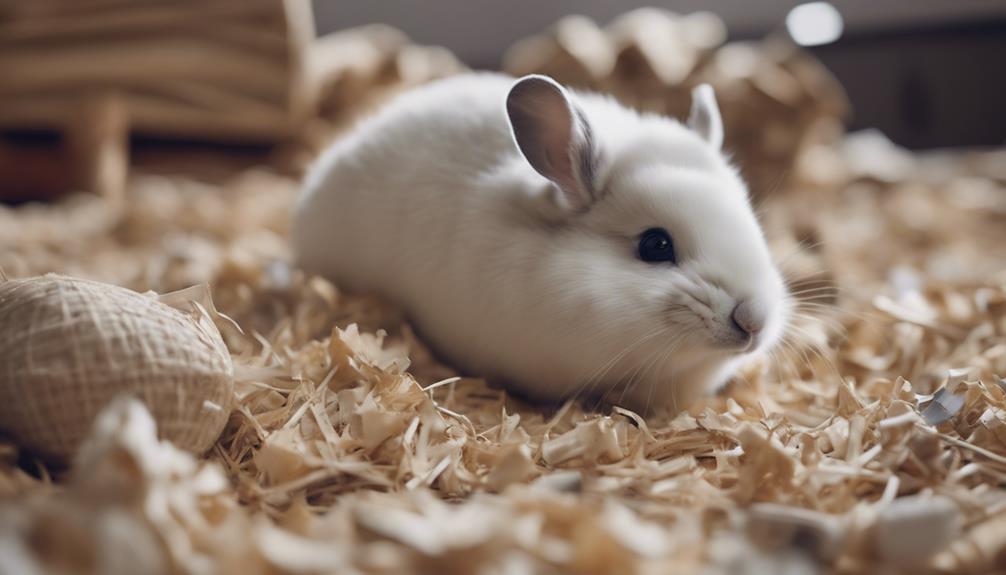
Selecting appropriate bedding materials for your chinchilla's habitat is crucial for ensuring their comfort and well-being in captivity. Chinchillas have specific preferences when it comes to bedding options, and providing the right materials can contribute to creating a naturalistic habitat that promotes environmental enrichment for these small creatures.
Here are some recommended bedding options and considerations for chinchilla habitats:
- Aspen Shavings: Chinchillas enjoy burrowing and nesting in aspen shavings, as they're safe and non-toxic for these sensitive animals.
- Paper-Based Bedding: Soft paper-based bedding is another excellent choice, providing a comfortable and dust-free environment for your chinchilla.
- Hay and Straw: Adding hay or straw to the bedding can simulate a more natural setting and encourage foraging behavior in chinchillas.
- Avoid Cedar or Pine Shavings: Steer clear of cedar or pine shavings, as they contain aromatic oils that can be harmful to chinchillas' respiratory systems.
Maintaining Optimal Temperature and Humidity
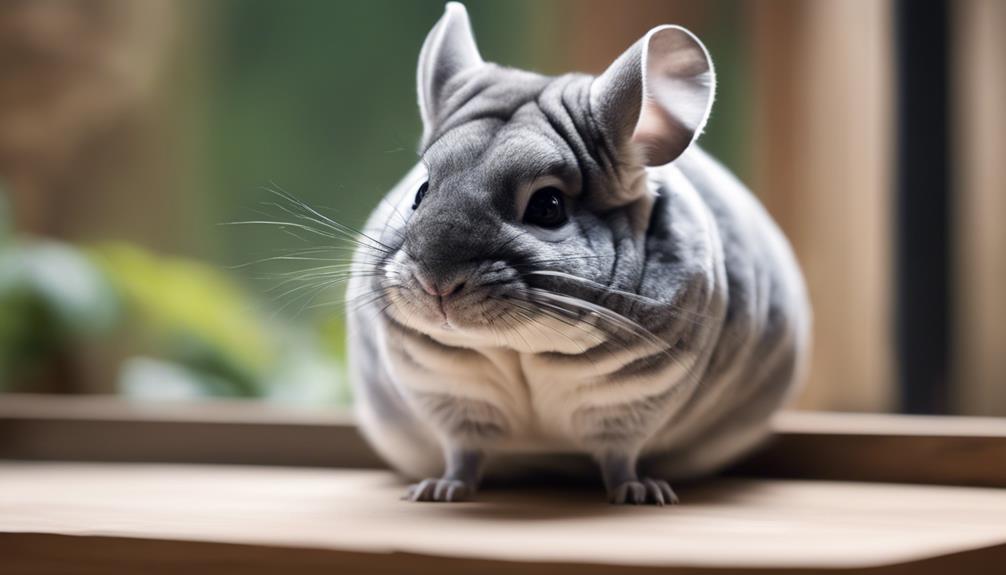
Maintaining the optimal temperature and humidity levels in a chinchilla habitat is essential to ensure the well-being and health of these small creatures in captivity. Proper temperature regulation and humidity control are key factors in creating an environment that mimics their natural habitat, contributing to their comfort and overall wellness. To achieve this, it is vital to simulate the environmental conditions that chinchillas are accustomed to, optimizing their comfort levels and reducing stress.
| Temperature Regulation | Humidity Control |
|---|---|
| Keep habitat between 60-70°F | Maintain humidity levels between 50-70% |
Chinchillas are sensitive to high temperatures and humidity, which can lead to heat stress and respiratory issues. By providing a habitat with the recommended temperature range and humidity levels, you can ensure that your chinchilla remains healthy and happy. Regular monitoring and adjustments will help in creating a safe and comfortable environment for these adorable pets.
Providing Enrichment Activities and Toys
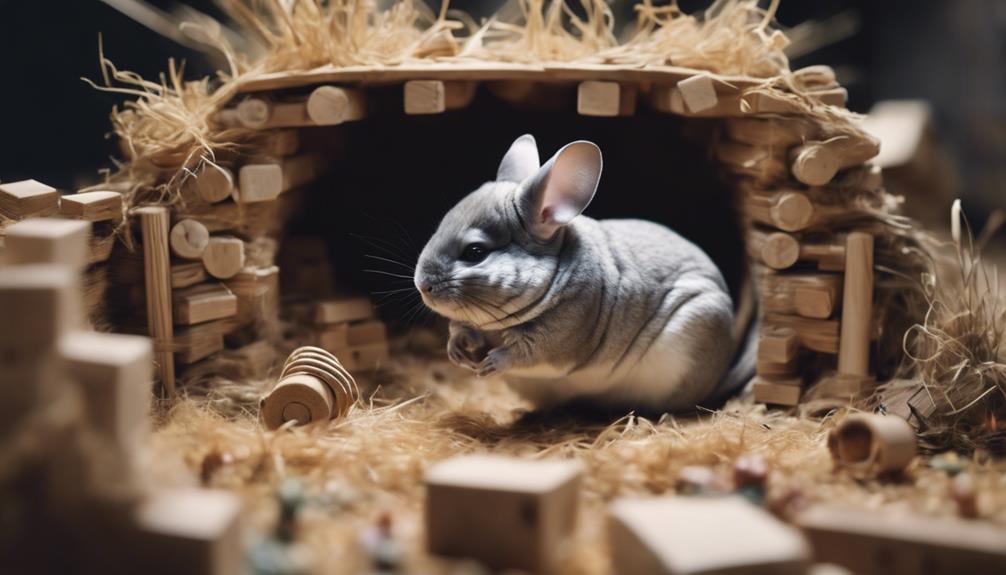
To enhance a chinchilla's habitat and promote their mental and physical well-being, introducing a variety of enrichment activities and toys is crucial. Chinchillas are intelligent and active animals that require stimulation to prevent boredom and encourage natural behaviors.
Here are some practical tips for providing enrichment activities and toys:
- Toy selection: Choose toys that are safe for chinchillas to chew on, such as wooden blocks or lava ledges. These toys help keep their teeth healthy and provide mental stimulation.
- Enrichment ideas: Rotate toys regularly to keep your chinchilla engaged and interested. Consider providing items like hay-filled balls or tunnels to encourage exploration and play.
- Interactive toys: Invest in interactive toys, such as puzzle feeders or treat dispensers, to challenge your chinchilla's problem-solving skills and keep them mentally sharp.
- DIY toys: Get creative and make your own toys using safe materials like untreated wood or cardboard tubes. DIY toys can be cost-effective and tailored to your chinchilla's preferences.
Creating Safe Hiding Spots and Shelter

When creating a habitat for a chinchilla that mimics its natural environment, ensuring safe hiding spots and shelters is essential for their comfort and security. Chinchillas are naturally inclined to seek out cozy burrows and secret nooks for safety and relaxation. To replicate this environment in captivity, providing them with hideaways such as wooden houses, tunnels, or nesting boxes is crucial. These spaces should be made of safe materials, free from sharp edges or small openings that could trap or injure the chinchilla.
Additionally, placing these hiding spots strategically around the habitat allows the chinchilla to exhibit natural behaviors like burrowing and nesting. Chinchillas will appreciate having multiple options for shelter, especially if they're housed with companions, to reduce potential conflicts over territory.
Regularly inspecting and cleaning these hiding spots is important to ensure they remain safe and hygienic for the chinchilla. By prioritizing the creation of secure and comfortable shelters, chinchilla owners can contribute to their pets' well-being and happiness.
Offering a Balanced Diet and Fresh Water
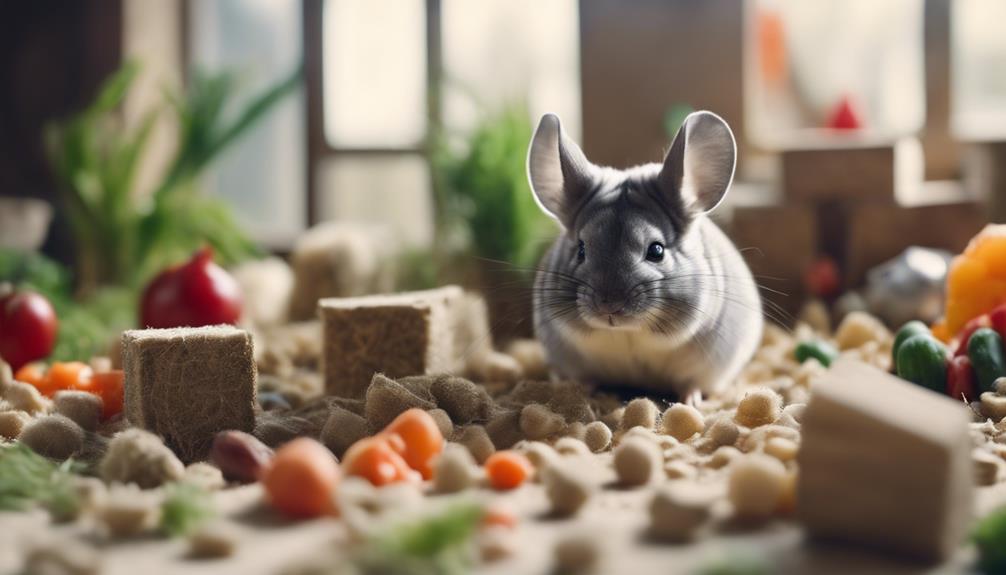
Ensuring a chinchilla's well-being necessitates providing a balanced diet and access to fresh water in their habitat. Proper nutrition and hydration are crucial for the health and happiness of these adorable creatures.
Here are some practical tips to help you meet your chinchilla's dietary and hydration needs:
- Nutritional Supplements: Chinchillas require a diet rich in high-quality hay, supplemented with pellets specifically formulated for them. These pellets are essential to ensure they receive all the necessary vitamins and minerals.
- Hydration: Fresh water should always be available to your chinchilla. Use a water bottle instead of a dish to prevent spills and contamination. Ensure the water is changed daily to maintain cleanliness and freshness.
- Feeding Schedule: Establish a consistent feeding schedule to regulate your chinchilla's food intake. This routine helps prevent overeating and ensures they receive the appropriate nutrients throughout the day.
- Water Bottle Placement: Position the water bottle in a convenient spot within the habitat, ensuring easy access for your chinchilla. Regularly check and refill the bottle to guarantee a continuous supply of clean water.
Monitoring Health and Well-being
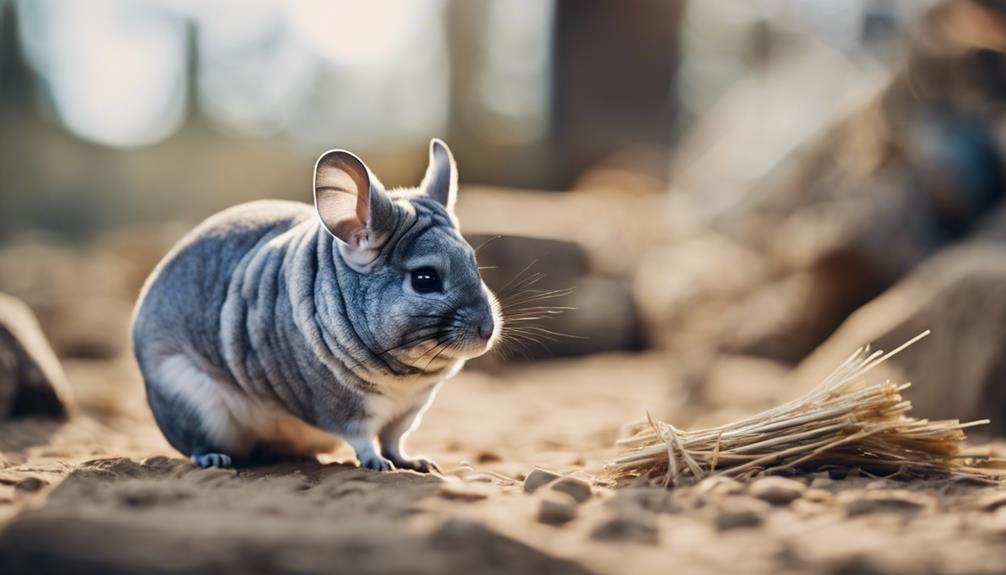
Maintaining vigilance over a chinchilla's health and well-being is paramount in ensuring their longevity and happiness in captivity. Regular check-ups by an experienced veterinarian are crucial to catch any health issues early on. These check-ups help in monitoring the chinchilla's weight, teeth, and overall physical condition.
Additionally, behavioral observations play a significant role in understanding a chinchilla's well-being. Changes in behavior like decreased activity, loss of appetite, or excessive grooming can be early indicators of health problems or stress. It's essential to create a baseline of normal behaviors for each chinchilla to better notice any deviations that might signal an issue.
Providing a safe and comfortable environment, a balanced diet, and regular exercise are also vital components of maintaining a chinchilla's health and well-being. By combining regular veterinary check-ups with attentive behavioral observations, chinchilla owners can ensure their furry companions lead happy and healthy lives in captivity.
Frequently Asked Questions
Can Chinchillas Be Kept as Pets in Households With Other Animals Such as Cats or Dogs?
Introducing chinchillas to other pets like cats or dogs requires careful supervision. Managing chinchilla and household dynamics involves gradual introductions, ensuring safety for all animals involved. Properly supervised interactions can lead to successful cohabitation.
How Often Should Chinchilla Cages Be Thoroughly Cleaned and Sanitized?
Like tending a garden, cleaning a chinchilla cage is vital for their well-being. Weekly spot cleaning and a thorough cleaning every 2-3 weeks maintain a healthy environment. Use pet-safe disinfectants and choose bedding wisely for optimal hygiene.
Are There Any Specific Plants or Herbs That Chinchillas Can Safely Nibble on in Their Habitat?
When it comes to safe foraging and enrichment activities for chinchillas, incorporating edible plants and herbs into their habitat can mimic their natural diet. Providing options like rosemary, basil, and dandelion greens can offer both nutrition and mental stimulation.
What Are Some Common Signs of Stress or Anxiety in Chinchillas, and How Can They Be Addressed?
Chinchillas, like delicate flowers in a storm, exhibit stress through behaviors like excessive grooming or aggression. Enrichment activities and gentle socialization techniques can aid in stress management, promoting happier and healthier chinchilla behavior.
How Can Chinchilla Owners Prevent Common Health Issues Such as Dental Problems or Fur Matting in Their Pets?
To prevent common health issues in chinchillas, owners can provide enrichment activities and diet supplements. Regular grooming techniques and exercise routines are essential. By incorporating these practices, chinchilla owners can help maintain their pets' overall well-being and health.











